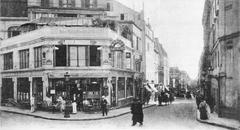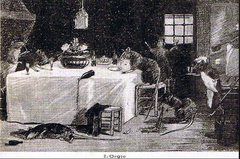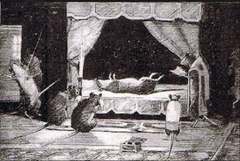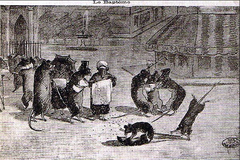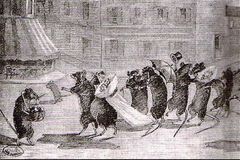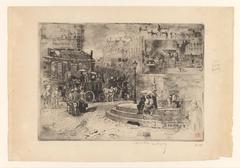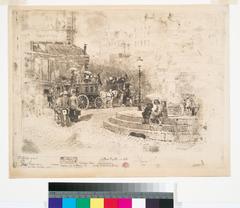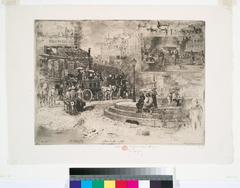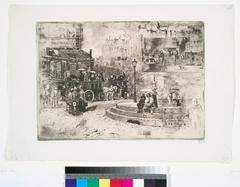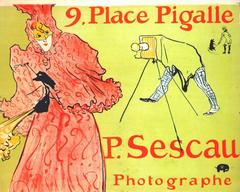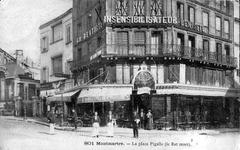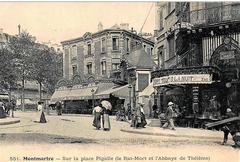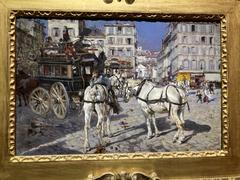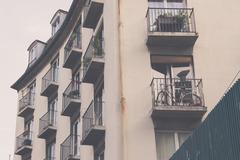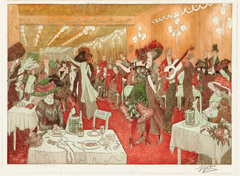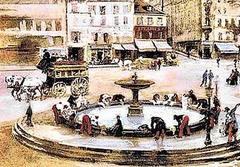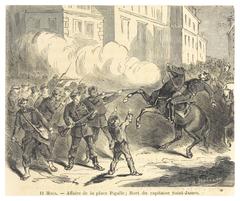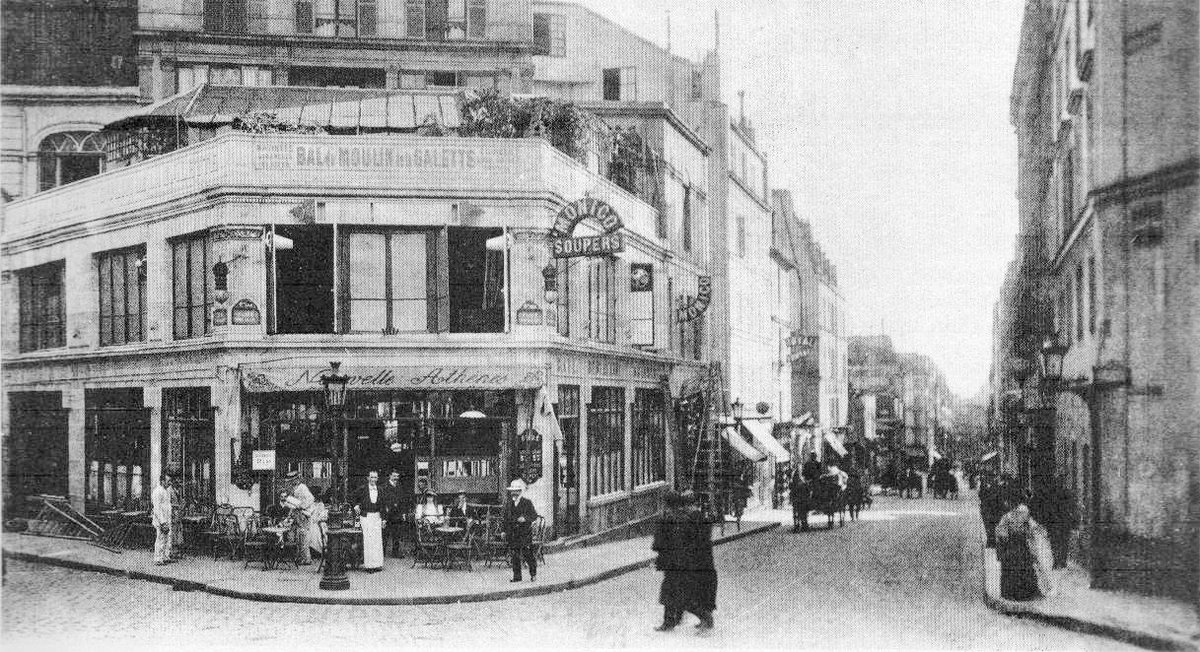
Place Pigalle Paris: Visiting Hours, Tickets, and Historical Sites Guide
Date: 14/06/2025
Introduction
Nestled at the crossroads of Paris’s 9th and 18th arrondissements, Place Pigalle stands as a testament to the city’s enduring artistic spirit and vibrant nightlife. Located at the southern foot of Montmartre, this square has long attracted bohemians, artists, and night owls, evolving from a tax boundary and red-light district into a dynamic neighborhood where tradition and innovation intersect. Today, Place Pigalle is celebrated for its historic cabarets, eclectic bars, boutique hotels, and rich cultural legacy—making it an essential stop on any Paris itinerary.
This guide offers a detailed overview of Place Pigalle’s history, cultural significance, visitor information (including hours, tickets, and accessibility), travel tips, nearby attractions, and recommendations for making the most of your visit. Whether your interests lie in art, music, food, or simply soaking up the electric ambiance, Pigalle promises a multifaceted Parisian experience.
For more guidance and insider tips, consult official Paris tourism resources and local guides (Wikipedia; Bonjour Paris; Sortir à Paris; Paris Info).
Table of Contents
- Historical Background
- Visitor Information
- Special Events & Guided Tours
- Photographic Spots
- Frequently Asked Questions (FAQ)
- Practical Tips
- Conclusion & Recommendations
- References
Historical Background
Origins and Early Development
Place Pigalle derives its name from the noted 18th-century sculptor Jean-Baptiste Pigalle. Originally serving as a tax boundary marked by the octroi gate (“Place de la Barrière-Montmartre”), the area separated taxed Paris from tax-free Montmartre (Wikipedia; Bonjour Paris; Visiting Paris By Yourself). This status made Pigalle a magnet for entertainment-seekers escaping city regulations.
Artistic and Bohemian Era
By the late 19th century, Pigalle had blossomed into a creative hub, drawing artists such as Toulouse-Lautrec, Picasso, Van Gogh, and Dalí. Cafés like the Nouvelle Athènes were immortalized in works by Degas and Manet. The area, adjacent to Montmartre, also became a gathering place for composers and poets, further cementing its bohemian reputation (Bonjour Paris).
Cabarets and Nightlife
The opening of the Moulin Rouge in 1889 marked Pigalle’s emergence as a nightlife epicenter. The district quickly filled with cabarets, music halls, and adult entertainment venues, including the famed Le Divan du Monde and Le Chat Noir (JetaimeMemeither; Parlez Moi de Paris). At its peak, over 60 venues crowded the streets, blending glamour and vice.
Interwar and Golden Age
During the 1920s–1960s, Pigalle thrived as a cosmopolitan hub. Jazz legends like Django Reinhardt, as well as American icons Josephine Baker and Adelaide Hall, performed here. The Grand Guignol theater was famous for its macabre shows. Pigalle’s nightlife became synonymous with both decadence and creative energy (Wikipedia; Visiting Paris By Yourself).
World War II and Postwar Decline
Despite wartime occupation, Pigalle’s nightlife continued, frequented by both Nazi officers and Free French. Postwar, the area became a red-light district, with sex shops and strip clubs flourishing, especially after the relaxation of French morality laws in the 1970s. Yet, the district’s musical and artistic legacy persisted, particularly along rue de Douai, known for its music shops (Bonjour Paris; Wikipedia).
Contemporary Renaissance
In recent years, Pigalle has undergone significant renewal. Trendy bars, boutique hotels, and artisanal restaurants have joined historic cabarets, revitalizing the area while maintaining its edgy charm. The district’s diverse architecture and blend of old and new now attract a cosmopolitan crowd (Parlez Moi de Paris).
Visitor Information
Visiting Hours & Access
- Place Pigalle (the square): Open 24/7, year-round.
- Cabarets and nightlife venues: Typically open from 7:00 PM to midnight or later. Check official venue websites for specific times.
- Museums: Most open from 10:00 AM to 6:00 or 7:00 PM (e.g., Musée Gustave Moreau; Musée de l’Érotisme).
Metro: Lines 2 & 12 (Pigalle station); numerous bus routes serve the area.
Tickets & Tours
- Moulin Rouge: Shows at 9:00 PM and 11:00 PM; tickets range from €90–€190. Book in advance (Moulin Rouge).
- Other venues: Check individual websites such as Le Divan du Monde and La Cigale for tickets and schedules.
- Guided tours: Walking and nightlife tours are offered by various operators. Booking ahead is recommended, especially for themed experiences.
Accessibility
- Place Pigalle: Open and mostly pedestrian-friendly.
- Metro: Pigalle station is not fully wheelchair accessible; check alternatives if needed.
- Streets: Some steep/cobblestone areas near Montmartre.
Travel Tips
- Safety: Pigalle is generally safe, especially South Pigalle. Exercise caution late at night, particularly north of Boulevard de Clichy. Be alert for pickpockets in crowded areas (Amber Everywhere; Travel Lemming).
- Currency: Euro (€); cards widely accepted.
- Language: French is primary, but English is common in tourist areas.
- Dress Code: Casual by day; smart attire for evening venues.
- Luggage Storage: Available via services like Radical Storage.
- Best Time to Visit: Evenings and weekends are lively; June brings long days and festivals (Paris Discovery Guide).
Special Events & Guided Tours
Place Pigalle is a focal point for cultural events, notably the annual Fête de la Musique (June 21), when the square becomes an open-air concert venue with free performances (sortiraparis.com). Throughout the year, local museums, galleries, and cabarets host exhibitions, shows, and themed evenings. Guided tours—ranging from art walks to nightlife explorations—can be booked through local operators and official tourism platforms.
Recommended Photographic Spots
- The iconic Moulin Rouge with its illuminated windmill
- Neon-lit Boulevard de Clichy after dark
- Café de la Nouvelle Athènes (now a hotel)
- Colorful street art and the Duperré playground
- Panoramic views from Montmartre
Frequently Asked Questions (FAQ)
Q: What are Pigalle’s main attractions and visiting hours?
A: Moulin Rouge (shows at 9 PM, 11 PM), Musée de l’Érotisme (11 AM–7 PM), and Musée Gustave Moreau (10 AM–6 PM). Check official websites for updates.
Q: How do I buy tickets for major venues?
A: Purchase directly from official sites like Moulin Rouge for authenticity and availability.
Q: Is Pigalle safe at night?
A: Yes, with standard urban precautions. Stick to well-lit streets and use licensed transport for late returns.
Q: Are guided tours available?
A: Yes, multiple operators offer themed tours focusing on nightlife, street art, and history.
Q: Is Pigalle accessible via public transport?
A: Yes, Pigalle Metro station (Lines 2 & 12) is centrally located; several bus lines and taxis are available.
Practical Tips
- Book tickets in advance for popular cabarets and events.
- Explore on foot for the best experience—Pigalle’s compact layout makes walking ideal.
- Sample local cuisine—don’t miss food shops on Rue des Martyrs and bars like Le Mondain or Bar à Bulles.
- Stay alert in crowded areas, particularly near nightlife hotspots and metro stations.
- Check event calendars for pop-up exhibitions, markets, or live music.
Conclusion & Recommendations
Place Pigalle remains a quintessential Parisian landmark where history, culture, and nightlife converge. Its evolution from bohemian enclave to cultural hotspot offers visitors a unique blend of tradition and modernity. With accessible transport, world-class venues, and a vibrant local scene, Pigalle promises a memorable experience for every type of traveler.
To maximize your visit:
- Plan ahead and book tickets for major attractions.
- Join a guided tour for deeper insight into Pigalle’s history and culture.
- Enjoy both the daytime charm and the district’s legendary nightlife.
- Download the Audiala app for offline maps, curated tours, and exclusive local tips.
Whether you’re drawn to artistic heritage, culinary delights, or the thrill of Paris after dark, Place Pigalle is a must-see destination.
References
- Pigalle, Paris, Wikipedia
- Une Petite Histoire de Place Pigalle, Bonjour Paris
- Pigalle Quarter: Touristic Interlope District, Visiting Paris By Yourself
- Historic Cabarets of Montmartre, JetaimeMemeither
- Quartier Pigalle, Parlez Moi de Paris
- Pigalle Neighborhood Guide, France Guide
- What to Do in Pigalle, Sortir à Paris
- Fête de la Musique 2025 at Place Pigalle, Sortir à Paris
- Official Paris Tourism Board, Paris Info
- Amber Everywhere: Is Paris Safe?
- Travel Lemming: Is Paris Safe?
- Travel Pander: What Places to Avoid in Paris?
- Paris Discovery Guide: Paris Events June
- HiP Paris: What to Do in Pigalle
- Do It In Paris: Best Places in Pigalle
- Radical Storage: Paris Safety Guide
